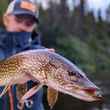Scott Hickman’s boat is worth more than my house and he drives it NASCAR fast. I can tell we are racing by how quickly we pinball through a few dozen oil tankers parked in the Gulf of Mexico.
“Oil is the new coal,” Hickman yells over the wind and the radio. “All these tankers are sitting out here empty.”
Hickman is a charter boat captain. Wait, that doesn’t sound quite right even if that’s what it looks like. He used to be charter. Now he’s commercial, but tourists are still on his boat. They’re his crew. I’m one of his crew members and I can already tell my saltwater fly rod is going to stay buried under three Texas-sized bean bag chairs that effectively absorb ramming speed over ocean waves. Hickman, owner of Circle H Outfitters and Charters, tells me the good fishing is 90 miles out and 90 feet deep. My fly rod doesn’t do that.
“When I say good, I mean the best in the country,” he says. “You just gotta run a little ways.”
Hickman is willing to run. He’s also willing to risk. He’s the first guy in the Gulf to dump charter for commercial and use tourists as his crew. He chartered as a hired guide for 30 years. He switched to a commercial permit in 2014. Fourteen more charters have followed suit since.
Tourists who fish with Hickman don’t pay him. Instead, they can buy fresh seafood at the end of the day that they learned to catch while working as Hickman’s crew. His catch-share concept is complicated. His motivation is simple.
“I didn’t want to dump fish anymore,” Hickman says. “Change is hard, but I was part of the problem. I was out here chewing through fish like a buzz saw.”
I chew on his buzz saw comment for days after the trip before the light comes on. The problem he’s referring to is high grading, dumping smaller fish when bigger fish make a better bag limit. It’s illegal, but it’s tough to regulate and practicing catch and release with ocean snapper is not the same as practicing catch and release on a trout stream.

“Catch and release is not an option with red snapper because they are usually 75 to 100 feet deep,” says Jeff Barger, Ocean Conservancy Association director for constituent outreach. “You’re probably killing 80 percent of fish on the trip to the surface.”
That means most red snapper thrown back die. Now compare that kill rate to what happens to fish in shallower depths, like river-raised trout. About 25 percent of trout caught on bait die when released. Ten percent of lure released trout die. Trout caught with a fly then released die four percent of the time. Release rates are better when you don’t fish deep. Hickman still fishes deep, but now he doesn’t release. Everything he catches goes on ice then sells at the marina’s fish house day of. Shane Cantrell does the same thing.
“Recreational fishers want big fish. We’re targeting average size fish and not throwing back. That’s the big thing,” says Cantrell, Charter Fisherman’s Association executive director and commercial permit holder. “That fish, when caught, needs to be harvested. I’m going to put it on ice, the fish house will sell it and someone will eat that fish.”

As a commercial crewmember for the day, my fish goes into the bucket too. It’s not the biggest catch, but it will feed a mouth. Or two. And I know my fly rod is better served below deck. It would never reel in the amount of red snapper we are hooking. They are rod benders, but come surprisingly easy when you watch someone who knows what they’re doing. Their catchability is part of the conundrum in the Gulf.
“Red snapper is not a difficult fish to catch,” Cantrell says. “They eat everything. Red snappers could help themselves by making themselves harder to catch.”

That’s not going to happen. The red snapper fishery is in rebuild mode and a fishery in rebuild mode needs patience and creativity. Sure Hickman’s catch-share concept is new and unusual in the Gulf, but it shouldn’t be dismissed because it’s different when doing the same old thing isn’t stabilizing the fishery. Red snapper fishing in the Gulf has been over quota on harvest limits 10 out of the last 15 years.
“Our management in the Gulf needs to be updated to the 21st century,” Cantrell says. “Nobody wants to be left out of the picture. By managing the fish properly, we’ll have more fish without leaving anyone out.”































Comments
Capt. Scott replied on Permalink
Great story, one thing is that it states high grading is illegal and actually it's legal in the
Fishery. The catch share experience there is no need to high grade as you can harvest what you catch and is based on a quota where no over fishing occurs. As far as trying to get around bag limits that's totally wrong. The majority of the harvest from these experience trips goes to local markets and restaurants. The experience fisherman learn about catch shares how they are rebuilding the fishery in an accountable sustainable way. They also have the ability to purchase part of the harvest from the market where the catch is landed weighed and deducted from the boats federal account. 3% of the boats sale is paid back to the government to pay for the program. Good old American thinking outside the box here. Everyone wins including the fish!
Matthew Herzog replied on Permalink
This is a great approach to fishery management. Throwing back any kind of bycatch is dumb.
Anonymous replied on Permalink
Simply disgusting....SH is a traitor to all fishermen,,,
Since the commercial sector obvious has quota to share, an allocation seems in order....
Again a real piece of crap is the only one who would do this.
Pages